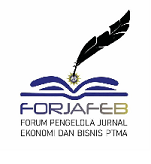DISPERSI GEOGRAFIS PERUSAHAAN TERHADAP PENGHINDARAN PAJAK DI INDONESIA
Abstract
The purpose of this study is to examine the influence of companies’ geographical dispersion on tax avoidance. The population in this research comprises all non-financial companies listed on the Indonesian Stock Exchange (IDX) in 2018. Moreover, 212 companies obtained using a purposive sampling method. The independent variable was geographical dispersion which measured using the standard deviation of the distance between the head office and branches. The higher standard deviation represents the more geographically dispersed company. Tax avoidance as the dependent variable was measured using the Effective Tax Rate (ETR). The lower ETR represents higher tax avoidance. Moreover, this research was included profitability as the controlling variable. The hypothesis was tested using multiple linear regression. It was indicated that geographical dispersion had a negative impact on tax avoidance. The more dispersed company, exhibit lower tax avoidance practices.
Keywords
Full Text:
PDFReferences
Astuti, T. P., & Aryani, Y. A. (2016). Tren Penghindaran Pajak Perusahaan Manufaktur Di Indonesia Yang Terdaftar Di BEI Tahun 2001-2014. Jurnal Akuntansi, XX(03), 375–388.
Brian, I., & Martani, D. (2014). Analisis Pengaruh Penghindaran Pajak dan Kepemilikan Keluarga Terhadap Waktu Pengumuman Laporan Keuangan Tahunan Perusahaan. Finance and Banking Journal, 16(2), 125–139.
Gallemore, J., & Labro, E. (2015). The Importance of The Internal Information Environment for Tax Avoidance. Journal of Accounting and Economics, 60(1), 149–167.
Ghafoori, J., & Rahmani, M. (2017). Impacts of Firms ’ Internal Information Environment on Tax Avoidance ( Case Study : Companies Listed in Tehran ’ s Stock Exchange ). Journal of History Culture and Art Research, 6(1), 106–120.
Hendrayady, A. (2018). Strategi Pembangunan Wilayah Perbatasan Provinsi Kepulauan Riau. Jurnal Ilmu Administrasi Negara, 6(1), 1–10.
Hope, O., Ma, M., & Thomas, W. B. (2012). Tax Avoidance and Geographic Earnings Disclosure. Deloitte Professorship Research.
John, G., & Eva, L. (2014). The Importance of the Internal Information Environment fot Tax Avoidance. Journal of Accounting and Economics, 1(1).
Lanis, R., & Richardson, G. (2013). Corporate Social Responsibility and Tax Aggressiveness: A Test of Legitimacy Theory. Accounting, Auditing and Accountability Journal, 26(1), 75–100.
Putra, H. A., & Ardiyanto, M. D. (2017). Pentingnya Kualitas Informasi Internal Terhadap Penghindaran Pajak. Diponegoro Journal of Accounting, 6(3), 448–461.
Rahardjo, A. (2008). Pengembangan Wilayah : Konsep dan Teori. Yogyakarta: Graha Ilmu.
Rica, & Trisnsawati, E. (2019). Faktor-Faktor yang Mempengaruhi Penghindaran Pajak pada Perusahaan Manufaktur. Jurnal Multiparadigma Akuntansi Tarumanagara, 1(1).
Sodik, J., & Iskandar, D. (2007). Aglomerasi dan Pertumbuhan Ekonomi: Peran Karakteristik Regional di Indonesia. Jurnal Ekonomi Dan Studi Pembangunan, 8(2), 117–129.
Su, K., Li, B., & Ma, C. (2019). Corporate Dispersion and Tax Avoidance. Chinese Management Studies.
Suarningrat, L. F., & Setiawan, P. E. (2013). Manajemen Pajak Sebagai Upaya Untuk Efisiensi Pajak Penghasilan Wajib Pajak Badan. Jurnal Akuntansi Universitas Udayana, 5(2), 291–306.
Sugeng, B. (2011). Pengaruh Perencanaan Pajak Terhadap Efisiensi Beban Pajak Penghasilan. Jurnal Riset Akuntansi Dan Bisnis, 11(2), 122–139.
Verawati, D. (2015). Pengaruh Diversifikasi Operasi, Diversifikasi Geografis dan Ukuran Perusahaan terhadap Manajemen Laba. Jurnal Akuntansi & Manajemen, 3(1), 1–92.
Zheng, S. (2017). Can corporate diversification induce more tax avoidance practices. Journal of Multinational Financial Management, 3(5), 1–14.
DOI: https://doi.org/10.32502/jab.v6i1.3400
Refbacks
- There are currently no refbacks.
Program Studi Akuntansi Fakultas Ekonomi dan Bisnis, Universitas Muhammadiyah Palembang
Jl. Jenderal A. Yani 13 Ulu, Seberang Ulu II, Palembang (30263), Indonesia.
Indexed by :














.jpg)


